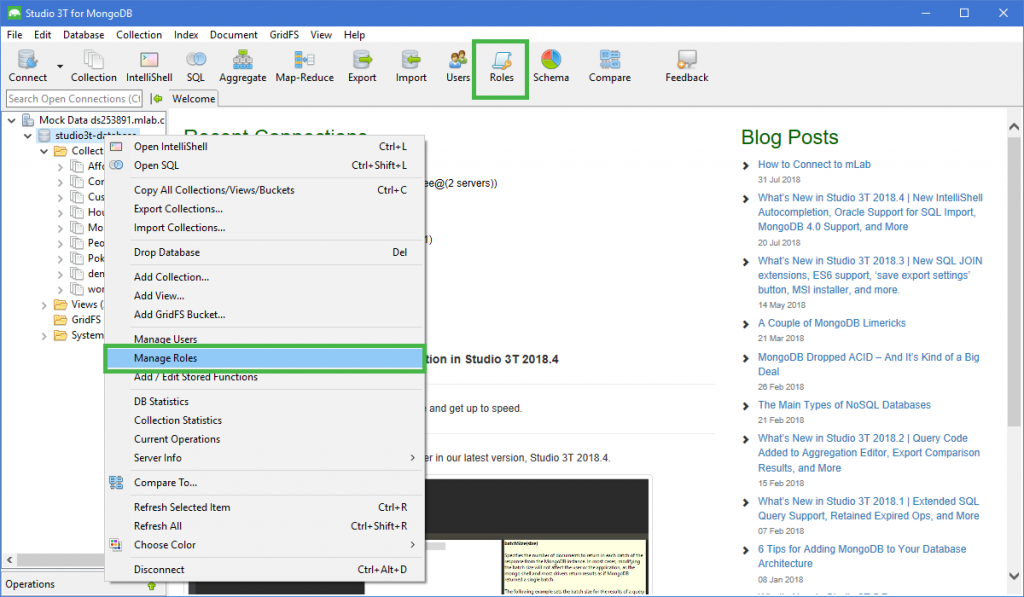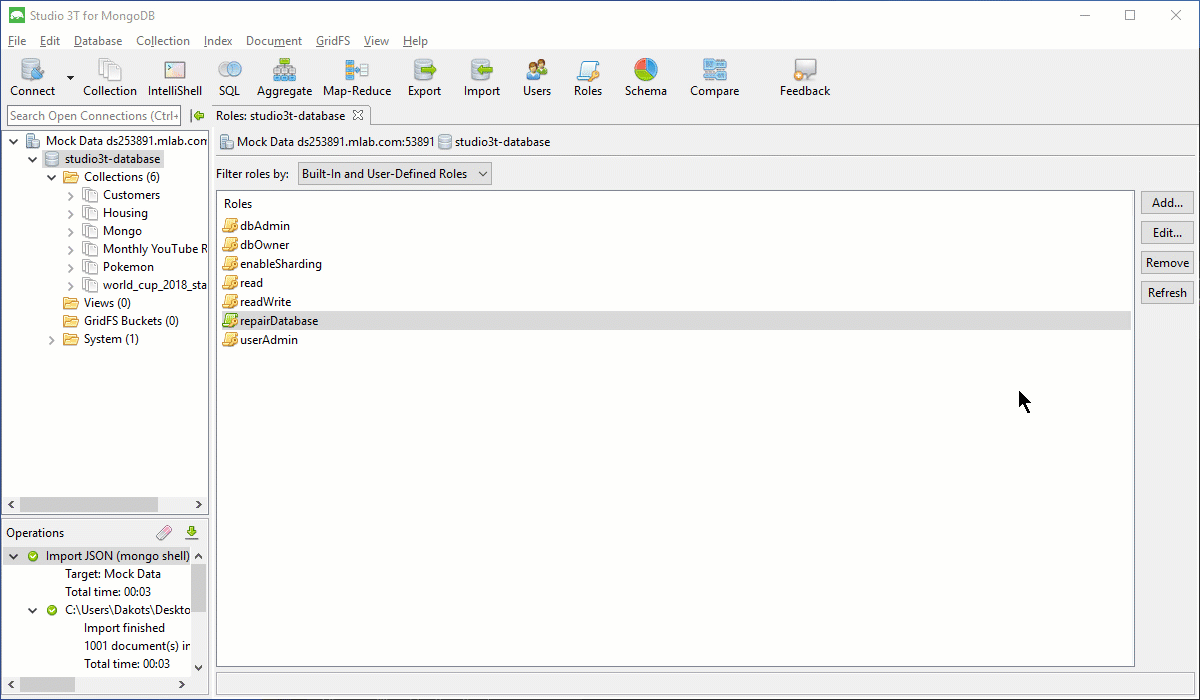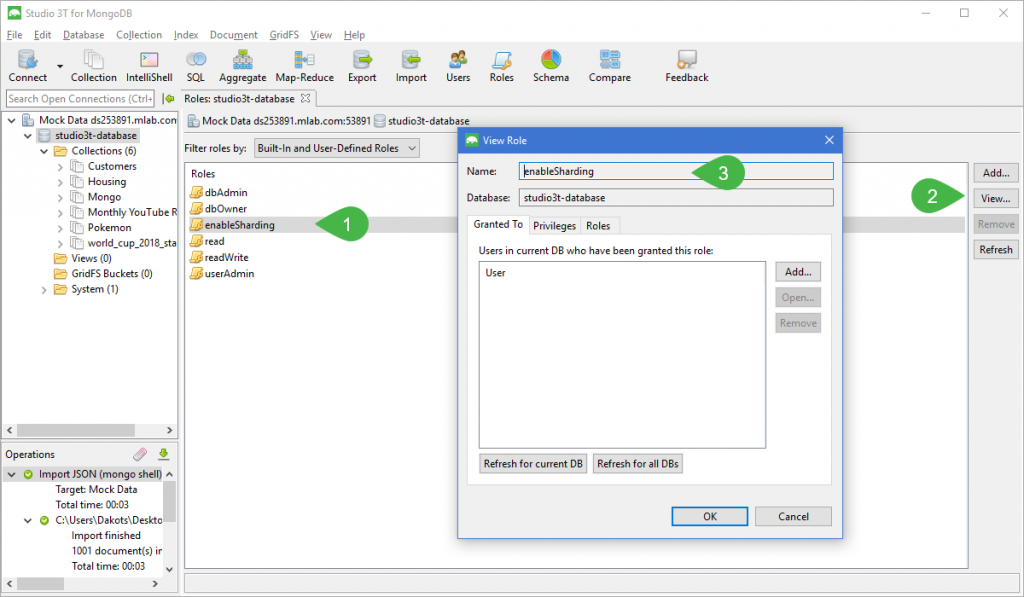Basics
Studio 3T’s Role Manager makes it easy to assign built-in roles and user-defined roles and list MongoDB users by role. But first, let’s look at a few basic concepts.
MongoDB privileges
A privilege is the foundation of a MongoDB role. It is made up of a resource and actions.
MongoDB resources
A resource is where the privileges are applied to, be it a cluster, a database, or specific collections within a database. You can choose one of three built-in resource options in Studio 3T:
- Resource: Database/Collection – Choose Database/Collection to define the database and specific collection(s) the user should have access to.
- Resource: Cluster – Use the Cluster resource for actions that affect the state of the system, e.g. shutdown, replSetReconfig, and addShard.
- Resource: Any Resource (anyResource) – The internal resource anyResource gives access to every resource in the system and is intended for internal use. Use only in exceptional circumstances.
MongoDB (privilege) actions
Actions define what a user can do within a MongoDB resource.
You can find a list of privilege actions here. If you already know which actions to choose, skip to the next chapter.
Open Role Manager
To open Role Manager:

- Button – Click on Roles in the global toolbar
- Right-click – Right-click on any target database in the Connection Tree and choose Manage Roles
Create a new role
- Open Role Manager and click on Add.
- Enter a name for the new role and ensure that the target database is correct.
- To inherit privileges from existing roles, click on the Roles tab and add the relevant role. This will spare the manual task of adding resources and actions step by step.
- Click on the Privileges tab.
- Click on Add.
- Choose the appropriate resource and click OK.
- Choose the appropriate actions and click OK.
- Check that everything is correct and click Create Rule.

View a role
- Open Role Manager and choose a role.
- Click on View to open the role profile and implement any changes.

Remove a role
- Open Role Manager and select a role.
- Click on the Remove button.
- Click Yes to delete the role.

Find users granted a specific role
In MongoDB, users are defined for specific databases. Each user is then assigned a number of roles that in turn define the user’s privileges.
While MongoDB’s API makes it trivial to list all roles that a particular user has been granted, there is unfortunately no easy way for the reverse case where you want to find all users that have been granted a particular role, i.e. the role’s grantees. Studio 3T makes it very easy to find those users.
List MongoDB roles
First off, connect to your MongoDB server as a user that has sufficient privileges to manage users and roles.
Then, simply select the database that contains the role for which you want to find all grantees.
Click the “Roles” icon in the toolbar.

Inspect selected MongoDB role
This will open the roles management tab for this database.
Here, you can see all the built-in and user-defined roles created for the database.
Now, simply select the role for which you want to see all the users that have been granted that role. In our case, that is the user-defined role “rwAdmin”.
Then click the “Edit” button.

List MongoDB users with the selected role
By default, In the “Granted To” tab, you can see all grantees from the same database that the role is defined in.
In our case, that is natalie, paul, peter, and richard.
If you want to see all users from all databases that have been granted role “rwAdmin”, click the “Refresh for all DBs” button.

That’s it! You can now see all users from all databases that have been granted the role “rwAdmin” on our database “test”.
Modify MongoDB roles
In this view, you can now even conceptually add new users to this role. For this, click the “Add” button.

In the new dialog, you can choose users from any database that you want to add to the role.
Of course, users in MongoDB are not really added to a role. Rather, under the hood, the selected users will be granted the role instead. Click “Add” to add the selected users.
Privilege actions
User can perform the addShard command. Apply this action to the cluster resource.
Allows any action on a resource. **Do not** assign this action except for exceptional circumstances.
User can append notes to the oplog. Apply this action to the cluster resource.
User can perform the logApplicationMessage command. Apply this action to the cluster resource.
User can perform the authSchemaUpgrade command. Apply this action to the cluster resource.
User can change the custom information of any user in the given database. Apply this action to database resources.
Users can change their own custom information. Apply this action to database resources.
Users can change their own passwords. Apply this action to database resources.
User can change the password of any user in the given database. Apply this action to database resources.
User can perform the cleanupOrphaned command. Apply this action to the cluster resource.
User can perform the closeAllDatabases command. Apply this action to the cluster resource.
User can perform the collMod command. Apply this action to database or collection resources.
User can perform the collStats command. Apply this action to database or collection resources.
User can perform the compact command. Apply this action to database or collection resources.
User can perform the connPoolStats and shardConnPoolStats commands. Apply this action to the cluster resource.
User can perform the connPoolSync command. Apply this action to the cluster resource.
User can perform the convertToCapped command. Apply this action to database or collection resources.
User can enable and use the CPU profiler. Apply this action to the cluster resource.
User can perform the db.createCollection() method. Apply this action to database or collection resources.
Provides access to the db.collection.createIndex() method and the createIndexes command. Apply this action to database or collection resources.
User can create new roles in the given database. Apply this action to database resources.
User can create new users in the given database. Apply this action to database resources.
User can perform the cursorInfo command. Apply this action to the cluster resource.
User can perform the dbHash command. Apply this action to database or collection resources.
User can perform the dbStats command. Apply this action to database resources.
User can perform the diagLogging command. Apply this action to the cluster resource.
User can perform the db.collection.drop() method. Apply this action to database or collection resources.
User can perform the dropDatabase command. Apply this action to database resources
User can perform the dropIndexes command. Apply this action to database or collection resources.
User can delete any role from the given database. Apply this action to database resources.
User can remove any user from the given database. Apply this action to database resources.
User can perform the emptycapped command. Apply this action to database or collection resources.
User can perform the db.setProfilingLevel() method. Apply this action to database resources.
User can enable sharding on a database using the enableSharding command and can shard a collection using the shardCollection command. Apply this action to database or collection resources.
User can perform the db.collection.find() method. Apply this action to database or collection resources.
User can perform the flushRouterConfig command. Apply this action to the cluster resource.
User can perform the fsync command. Apply this action to the cluster resource.
User can perform the getCmdLineOpts command. Apply this action to the cluster resource.
User can perform the getLog command. Apply this action to the cluster resource.
User can perform the getParameter command. Apply this action to the cluster resource.
User can perform the getShardMap command. Apply this action to the cluster resource.
User can perform the getShardVersion command. Apply this action to database resources.
User can grant any role in the database to any user from any database in the system. Apply this action to database resources.
Provides information about the server the MongoDB instance runs on. Apply this action to the cluster resource.
User can perform the indexStats command. Apply this action to database or collection resources.
User can use the db.currentOp() method to return pending and active operations. Apply this action to the cluster resource.
User can perform the insert command. Apply this action to database or collection resources.
Allows internal actions. **Do not** assign this action except for exceptional circumstances.
Provides access to the invalidateUserCache command. Apply this action to the cluster resource.
User can kill cursors on the target collection.
User can perform the db.killOp() method. Apply this action to the cluster resource.
User can perform the listCollections command. Apply this action to database resources.
User can perform the listDatabases command. Apply this action to the cluster resource.
User can perform the ListIndexes command. Apply this action to database or collection resources.
User can perform the listShards command. Apply this action to the cluster resource.
User can perform the logRotate command. Apply this action to the cluster resource.
User can perform the netstat command. Apply this action to the cluster resource.
User can perform the planCacheListPlans and planCacheListQueryShapes commands and the PlanCache.getPlansByQuery() and PlanCache.listQueryShapes() methods. Apply this action to database or collection resources.
User can perform the planCacheClear command and the PlanCache.clear() and PlanCache.clearPlansByQuery() methods. Apply this action to database or collection resources.
User can perform the reIndex command. Apply this action to database or collection resources.
User can perform the db.collection.remove() method. Apply this action to database or collection resources.
User can perform the removeShard command. Apply this action to the cluster resource.
User can perform the repairDatabase command. Apply this action to database resources.
User can configure a replica set. Apply this action to the cluster resource.
User can configure a replica set. Apply this action to the cluster resource.
User can perform the replSetGetStatus command. Apply this action to the cluster resource.
User can perform the replSetHeartbeat command. Apply this action to the cluster resource.
User can perform the resync command. Apply this action to the cluster resource.
User can remove any role from any user from any database in the system. Apply this action to database resources.
User can perform the serverStatus command. Apply this action to the cluster resource.
User can perform the setParameter command. Apply this action to the cluster resource.
User can perform the shardingState command. Apply this action to the cluster resource.
User can perform the shutdown command. Apply this action to the cluster resource.
User can perform the splitChunk command. Apply this action to database or collection resources.
User can perform the splitVector command. Apply this action to database or collection resources.
User can perform the storageDetails command. Apply this action to database or collection resources.
User can perform the top command. Apply this action to the cluster resource.
User can perform the touch command. Apply this action to the cluster resource.
User can perform the db.fsyncUnlock() method. Apply this action to the cluster resource.
User can perform the update command. Apply this action to database or collection resources.
User can perform the validate command. Apply this action to database or collection resources.
User can view information about any role in the given database. Apply this action to database resources.
User can view the information of any user in the given database. Apply this action to database resources.









